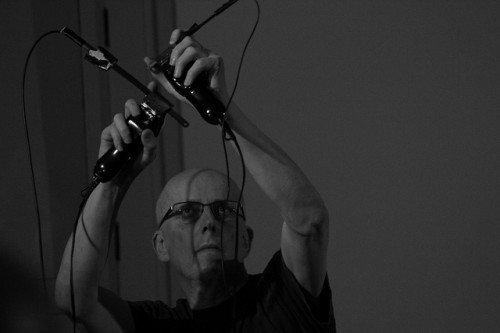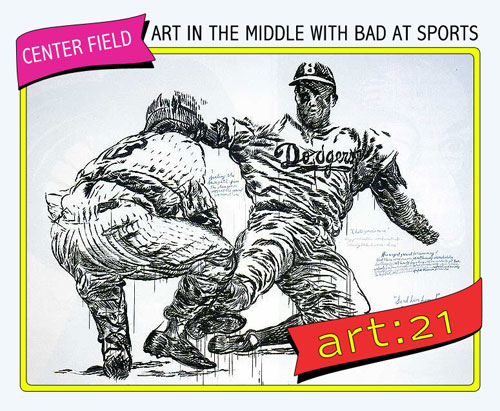Presented by Lampo, a Chicago-based nonprofit presenter of experimental music and intermedia events, and the Graham Foundation, an organization that makes project-based grants to individuals and organizations and also produces public programs, Leif Elggren performed last November as part of LAMPO’s performance series at The Graham Foundation. Elggren has a varied and interesting past — along with Carl Michael von Hausswolff, Elggrene is, for instance, one of the kings of Elgaland-Vargaland: a digital territory that “consists of all Border Territories: Geographical, Mental & Digital.” It is one of the most visited territories in the world. He was born in Sweden in 1950, currently lives in Stockholm, and creates experimental music that integrates visual components. He has many albums to his name, has been working with Kent Tankred under the moniker Guds Soner (or The Sons of God) and represented Sweden at the Venice Biennale in 2001. I was thinking about his LAMPO performance because of the way it dissolved the space between myself (the listener) and the sound.

Leif Elggren with amplified electric shavers. Performance still, Chicago, November, 2011. Photo by Matthew Solarski.
We gathered in the upstairs auditorium of the Graham Foundation to watch Leif Elggren perform. Elggren is known for the ways in which he engages a liminal space, whether by collaborating with ghosts, or annexing the borders. He tries to access and name the marginal space between things, between what is alive and what is dead, what is a this and a that. In this particular instance, he first screened a video of drawings with music. Then he described a process by which he collaborates with the long-dead Emanuel Swedenborg, a scientist, philosopher and theologian from the 1700s. Towards the end of his life, Swedenborg began to have visions wherein he believed he was communicating directly with God. Elggren communicates with that spirit via invocation and an embodiment.
During the second part of his performance Elggren explained that the house belonging to Swedenborg had been torn down, but that the summer vestibule/one-room cottage where the man occasionally worked in his garden still remained. Elggren and a collaborator worked on-site, in this small room, conducting a series of recordings as Elggren read some of Swedenborg’s original writing. This was then mixed in a sound studio and came together in an album. He played a recording from this record — it sounded like a fuzzed-out, layered and thick hunk of distortion; the human voice was hard to discern, its words all the more impossible to distinguish. In many ways, I feel like this “song” was sort of like an entry point into Elggren’s Swedenborg collaboration — what would consume the rest of the evening.
For his next piece, he read (what I assume to have been) Swedenborg’s text — though perhaps the original author, whether Swedenborg or Elggren, is of no matter. Elggren stood behind a single microphone, his lean body flexed under the ecstacy of performance, each muscle rigid under the stress of delivery — even his voice seemed especially reedy, a pipe employed by a heteronym. What was disembodied now had a material passage with which to reach us. He raved like a madman : “It is said that a Queen has spies in her pockets. It is said that a Queen will be sad when the horses come to castle with bloody men on their backs….” Over and over again, the Queen took shape in different passages. I was reminded at this stage of Fernando Pessoa and Araki Yasusada: the way they each embodied an un”real” (in the conventional, material sense)-spirit, that nevertheless had “true” things to say, and “true” discernible personalities. Elggren’s Queen apparently knew something about martians, and cakes and husbands and — oh it was just so exquisite, a ludicrous tapestry, I couldn’t remember its parts if I tried. I think I took it all in too quickly, too deeply, astounded as I was by the commitment behind Elggren’s performance.
You see, this was another primer. We were heading into the deepest part of the “medicine space” if you will — our automatic defenses were breaking down along the path he brought us through. Once Elggren again took his seat, he pulled out two electric hair clippers. Saw blades had been fitted between the clipper blade and the clipper, held fast by the clipper screw. The saw was intended to buzz up and down within its clasp. Elggren ran the clippers through pedals and created a steadily amplifying and increasingly intense, variant vibration. It filled the room completely.
The air buzzed, and sometimes he left the clippers on the table to buzz that surface. It began like the sound of a lawn mower in many places at once — one sound and many, captivating in its rebellion against logic. The razor-gnashing sound rose to our sonic surface, maintaining all the time a deep, rumbling underbelly — remember the middle sound is the lawn mower (in many ways, keeping track of that center, at first kept me centered in myself) — everything concocted via a precarious balance of fingers and shears, rasping up against one another and about to fall apart; it was as if Elggren was weaving vibrations into the air. Again he was visibly, physically stressed: a flex of muscles, like a concentrated dancer. At any moment the saw blades threatened to fall out of their rudimentary clasps, ceasing altogether. It was this threat that Elggren modulated so intuitively. And the sound grew ever louder — aggressive and relentless and piercing — the vibrations began to thrum through my body. I could no longer command a central calm, powerless to steel myself against the invasion. The bounds between my inside and my out dissolved in the intensity of buzzing. The sound was complex and layered with an infinite many notes contained therein and no fast foothold to grasp. It was/is a little hard to breathe. Mesmerizing wringing with great satisfaction vibrated/vibrates your whole head dissolving of self into sound like that irony about suffering when you suffer even while asking life its purpose the purpose is clear only in happiness do we lapse into confusion malaise the doldrums of heaven the uselessness of breath because in this sound one is inextricably connected to identifying with and wrenching from the sound as a primary threat. We need want pain but pretend otherwise disguising desire with a pledge for happiness and fall back into sleep.
When it finally subsided, I was shocked to find the course of my thoughts — because pain created such a steady vehicle for concentration, I had in that moment imagined it desirable; pain is a focal point. It establishes a center for meaning and catharsis: this is what came from the buzzing hair clippers. In this particular instance, the sound had been so overwhelming as to possess my whole body (like a ghost, perhaps), to drown out my heartbeat and produce pain and pleasure simultaneously.
After this, we began to drift back into the present, but still slowly. Elggren replayed a recording of what we had just experienced. The vibrations were less potent this time, like an echo from the past; the audience had more distance, more space to reflect. Our individuality and separateness began to return, like blood flooding back where it had been cut off. The relief of one’s own heartbeat. Six people in black, including Elggren, sat in chairs at the front of the room during this replay. They embodied the process of the sound, reenacting hysteria (variously) — mirroring the interior experience I had just endured. Their positions reminded me of commuters on the train — as they sat side by side — and here again I realized we were moving back into the world, where I remembered suddenly the concept of work and wages and all the trips to and from work. Each body in his or her own way displayed a unique and slow-motion form of discomfort through twitches and grimaces and slumps until the noise died down again and the bodies resumed their original seats, much like we had, as though nothing had happened.




